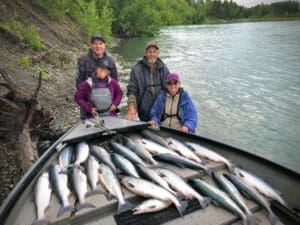5 ways to land way more sockeye salmon on the Kenai river:
Use heavy gear – Sockeye salmon run around 5-8 pounds on the Kenai River, but it’s not only the weight of the fish you’re in a battle with. There’s also a swift current, and sockeye know how to use it to their advantage. In addition, you’re stuck in one place on the bank, unable to chase the fish, often with other anglers in close proximity. Being under-gunned in this situation is a common cause for lost sockeye. Your rod should be rated to 20+lb test if using conventional gear, or be at least a 9 weight if you’re using a fly rod. Your main line and leader should be in the 30lb test range. Any lighter and you risk getting overpowered by the fish and the current.
Keep your rod low – You were probably taught to “keep your tip up” when learning how to fish, and in many fishing scenarios that’s good advice. The reason for this advice is to keep a bend in your rod, which acts as a shock absorber when your fish makes a sudden, powerful move. But the rod-bend doesn’t have to be up, as the same shock-absorption can be achieved by holding your rod low and to the side. This keeps the fish under the water more of the time, which gives you the advantage of water-resistance, lowering the impact of each violent head shake, increasing the odds of the hook staying in the fish. It’s science!
Hook selection – Choosing a high quality hook that will stay sharp is one of the most important factors to landing more fish. You’ll want a hook small enough to easily penetrate the mouth of a sockeye, but large enough that the purchase will be significant enough to hang on to the fish for the entirety of the fight. A 2/0 Gamakatsu octopus style hook is the standard go-to hook on the Kenai River, but something slightly smaller or larger may be more effective in different current speeds. Everyone has a favorite hook type, so experiment and see what works best for you. Whichever hook you choose, keep it sharp!
Good netter – Netting sockeye salmon is a skill that takes experience to master, and even when you’ve mastered it, you’re occasionally made the fool by a feisty fish. The key to netting sockeye, or any fish, is to wait for the right moment, don’t rush it, and never net tail-first. If you make a stab at the fish and it isn’t going as planned, pull away and wait for another chance. When fishing a gravel bar with a gentle slope and few obstacles, dragging the fish up may be a better option than chasing it around with a net.
Let ’em run – I see more sockeye get off the hook because anglers start with their drag too tight than anything else. The first 10 seconds of the fight is typically the most intense as the fish has all of its energy, and is full of adrenaline from the realization that it’s been hooked. If the fish makes a crazy run at first, just let it happen. If the fish is hooked in the mouth, it’ll calm down and allow you to gain the line back.
Hook them in the mouth – It’s amazing how much harder a sockeye salmon can pull when it’s snagged. The vast majority of snagged fish either pull free or break the line. They are also illegal to harvest, waste your precious fishing time, and are extremely hard on your gear, so avoiding foul hooked fish is always the best plan. A good fishing guide will teach you riggings and methods that avoid too many snagged sockeye such as effective swinging pace, hook selection, leader length, etc.
If you want to experience the most popular salmon fishery in Alaska, sockeye fishing on the Kenai River or Kasilof River, then get in touch with us here at Fishology and we’ll be glad to get you on board. Many peak season dates are still available… One of our master “fishologists” will surely have you catching fish & HAVING FUN in no time!


0 Comments